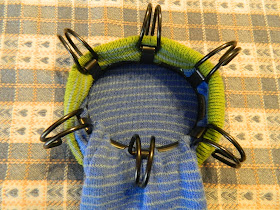~~~~~~~~~~~~~~~~~~~~~~~~~~~~~~~~
1. What am I working on?
Once in awhile I run across a crochet pattern that screams "This is it!" I really enjoy quick projects that come with a big dose of instant gratification, and this one has just that. This free dishcloth pattern is quick, has lots of texture and actually looks something like its namesake. Zinnia.The best part is they are useful. They can be used to wash dishes or as a washcloth. They stack well and never need folding...yay!
Look at all that color and texture. They look good just laying around, too. It's a great pattern. Go ahead, make your own fun stack of cloths.
The colors I used for the cloths were inspired by this photo.
 |
| Source |
2. How does my work differ from others of its genre?
Actually, questions like this never cross my mind. I just make whatever I like. Remember these dryer balls? :))
My projects either make me happy or are useful in some way.
 |
| Dyeing yarn for one of the cloths. |
It varies with the project. Sometimes I use patterns, other times I just wing it.
Speaking of winging it, yesterday Goodman and I visited a birding park in our area.
 |
| More info on the park here. |
Here's a photo of the barn at the entrance replete with a bluebird barn quilt. Love that barn quilt.
 |
Have a great week, Y'all!
Shared at The Art of Home-Making Mondays, The Backyard Farming Connection, Good Fences





























.jpg)
































